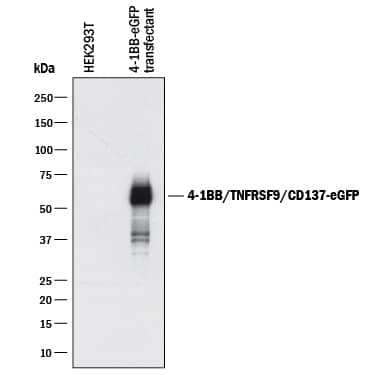Human 4-1BB/TNFRSF9/CD137 Antibody
R&D Systems, part of Bio-Techne | Catalog # AF838


Key Product Details
Validated by
Species Reactivity
Validated:
Cited:
Applications
Validated:
Cited:
Label
Antibody Source
Product Specifications
Immunogen
Leu24-Gln186
Accession # Q07011
Specificity
Clonality
Host
Isotype
Endotoxin Level
Scientific Data Images for Human 4-1BB/TNFRSF9/CD137 Antibody
Detection of Human 4‑1BB/TNFRSF9/ CD137 by Western Blot.
Western blot shows lysates of HEK293T human embryonic kidney cell line either mock transfected or transfected with human 4-1BB/TNFRSF9/ CD137-eGFP Fusion. PVDF membrane was probed with 0.5 µg/mL of Goat Anti-Human 4-1BB/ TNFRSF9/CD137 Antigen Affinity-purified Polyclonal Antibody (Catalog # AF838) followed by HRP-conjugated Anti-Goat IgG Secondary Antibody (]). A specific band was detected for 4-1BB/ TNFRSF9/CD137-eGFP Fusion at approximately 50-65 kDa (as indicated). This experiment was conducted under reducing conditions and using Immunoblot Buffer Group 1.4‑1BB/TNFRSF9/CD137 in Human Tonsil.
4-1BB/TNFRSF9/CD137 was detected in immersion fixed paraffin-embedded sections of human tonsil using Goat Anti-Human 4-1BB/TNFRSF9/CD137 Antigen Affinity-purified Polyclonal Antibody (Catalog # AF838) at 10 µg/mL overnight at 4 °C. Tissue was stained using the Anti-Goat HRP-DAB Cell & Tissue Staining Kit (brown; CTS008) and counterstained with hematoxylin (blue). Specific staining was localized to lymphocytes. View our protocol for Chromogenic IHC Staining of Paraffin-embedded Tissue Sections.Detection of 4‑1BB/TNFRSF9/CD137 in PHA-treated Human T Cells by Flow Cytometry.
Human T cells were treated for 48 hours with 5 µg/mL PHA then stained with Goat Anti-Human 4-1BB/TNFRSF9/ CD137 Antigen Affinity-purified Polyclonal Antibody (Catalog # AF838) followed by Allophycocyanin-conjugated Anti-Goat IgG Secondary Antibody (F0108) and PE-conjugated anti-human CD3 (Catalog # FAB100P). Quad marker was set based on control antibody (AB-108-C) staining.Applications for Human 4-1BB/TNFRSF9/CD137 Antibody
Agonist Activity
The ED50 for this effect is typically ≤ 20 μg/mL.
CyTOF-ready
Flow Cytometry
Sample: Human T cells treated with PHA
Immunocytochemistry
Sample: Immersion fixed human peripheral blood mononuclear cells
Immunohistochemistry
Sample: Immersion fixed paraffin-embedded sections of human tonsil
Simple Western
Sample: HDLM-2 human Hodgkin's lymphoma cells
Western Blot
Sample: HEK293T human embryonic kidney cell line transfected with human 4-1BB/TNFRSF9/CD137-eGFP Fusion
Human 4-1BB/TNFRSF9/CD137 Sandwich Immunoassay
Reviewed Applications
Read 1 review rated 5 using AF838 in the following applications:
Formulation, Preparation, and Storage
Purification
Reconstitution
Formulation
*Small pack size (-SP) is supplied either lyophilized or as a 0.2 µm filtered solution in PBS.
Shipping
Stability & Storage
- 12 months from date of receipt, -20 to -70 °C as supplied.
- 1 month, 2 to 8 °C under sterile conditions after reconstitution.
- 6 months, -20 to -70 °C under sterile conditions after reconstitution.
Background: 4-1BB/TNFRSF9/CD137
4-1BB is an inducible T cell surface protein belonging to the TNF receptor superfamily. It is alternatively known as TNFRSF9, CD137, and ILA. The 255 amino acid human 4-1BB is a type I transmembrane protein having in its extracellular domain four of the cysteine-rich motifs that are characteristic of the TNF receptor superfamily. The 30 kDa glycoprotein exists both as a monomer and as a dimer on T cells. The human and mouse proteins share 60% amino acid identity. 4-1BB is absent from naive T cells, but it is upregulated and continually expressed following T cell activation. The natural ligand, 4-1BBL, is a member of the TNF superfamily and is expressed on activated antigen presenting cells including dendritic cells, macrophages, and B cells. Cross-linking of 4-1BB by 4-1BBL or by agonistic antibodies transmits a potent co-stimulatory signal that enhances the effect of other activating signals such as PHA or anti-CD3 antibodies. 4-1BB signals through the
TFAF2‑NIK pathway resulting in activation of NF-kappa B and ultimately promoting proliferation and survival of T cells.
References
- Vinay, D. and B. Kwon (1998) Semin. Immunol. 10:481.
- Sica, G. and L. Chen (2000) Adv. Exp. Med. Biol. 465:355.
Alternate Names
Gene Symbol
UniProt
Additional 4-1BB/TNFRSF9/CD137 Products
Product Documents for Human 4-1BB/TNFRSF9/CD137 Antibody
Product Specific Notices for Human 4-1BB/TNFRSF9/CD137 Antibody
For research use only



